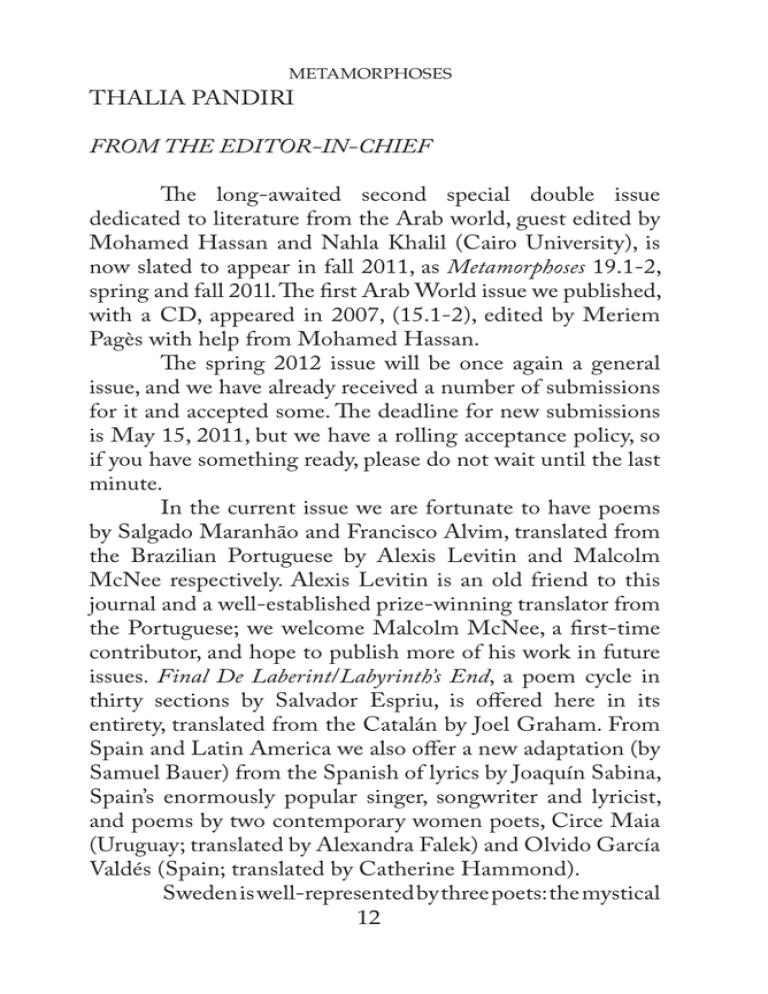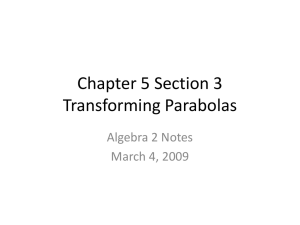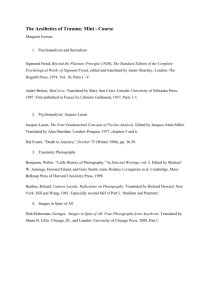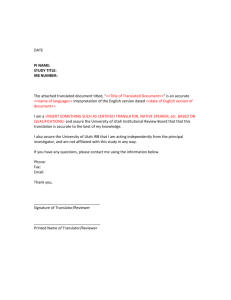THALIA PANDIRI The long-awaited second special double issue FROM THE EDITOR-IN-CHIEF
advertisement

METAMORPHOSES THALIA PANDIRI FROM THE EDITOR-IN-CHIEF The long-awaited second special double issue dedicated to literature from the Arab world, guest edited by Mohamed Hassan and Nahla Khalil (Cairo University), is now slated to appear in fall 2011, as Metamorphoses 19.1-2, spring and fall 201l. The first Arab World issue we published, with a CD, appeared in 2007, (15.1-2), edited by Meriem Pagès with help from Mohamed Hassan. The spring 2012 issue will be once again a general issue, and we have already received a number of submissions for it and accepted some. The deadline for new submissions is May 15, 2011, but we have a rolling acceptance policy, so if you have something ready, please do not wait until the last minute. In the current issue we are fortunate to have poems by Salgado Maranhão and Francisco Alvim, translated from the Brazilian Portuguese by Alexis Levitin and Malcolm McNee respectively. Alexis Levitin is an old friend to this journal and a well-established prize-winning translator from the Portuguese; we welcome Malcolm McNee, a first-time contributor, and hope to publish more of his work in future issues. Final De Laberint/Labyrinth’s End, a poem cycle in thirty sections by Salvador Espriu, is offered here in its entirety, translated from the Catalán by Joel Graham. From Spain and Latin America we also offer a new adaptation (by Samuel Bauer) from the Spanish of lyrics by Joaquín Sabina, Spain’s enormously popular singer, songwriter and lyricist, and poems by two contemporary women poets, Circe Maia (Uruguay; translated by Alexandra Falek) and Olvido García Valdés (Spain; translated by Catherine Hammond). Sweden is well-represented by three poets: the mystical 12 FALL 2010 poet, novelist and well-known intellectual Karin Boye, who committed suicide at the age of 41 in 1941 (translated by Gabriella Frykhamn and Michael Joyce); Margareta Ekström (translated by Eva Claeson) and Tom Hedlund (translated by Sarah Hollister). All of these poets are challenging to translate into English; while both are Germanic languages, English lacks the musicality of Swedish. Ekström seems in some way most accessible, easiest to identify with, even in translation. Hedlund’s poetry is powerful, and his rhythms come across well in Hollister’s translation. By far the greatest challenge faces a translator of Karin Boye’s poems. Short, stark words; deceptive simplicity yoked to passionate feeling and a soaring metaphysical sensibility; occasional rhymes; and the musicality and rhythms of the original—what is a translator to do? Frykhamn and Joyce do very well by the two poems published here, but there is a limit to what the English will do without sacrificing meaning. Compare the first line of “A Painter’s Wish” in the original and in translation: Jag ville måla ett ringa grand I wanted to paint even an insignificant study All the more impressive, then, that for all three of these poets, the translators have given English readers poetry in English that reflects each poet’s individual voice, and its power to move us. Canadian born poet Renée von Paschen contributes a group of poems (from 3 x 6 Snapshots/ 3 x 6 Schnappschüsse) which she wrote in English, and which are translated here by several translators: the poet herself; the poet as cotranslator with one of the other translators of her work; another translator working alone but, it would seem, with the consistent informal collaboration of the poet. Gerhild Krutak, Martin Schwehla, and Renée von Paschen have, severally and together, produced poems that are just as idiomatic in German as they are in English, with as much 13 METAMORPHOSES energy, ability to delight with the unexpected punch-line, as much music created by alliteration, assonance, rhythm. It’s a joy to be introduced to new authors and translators, and we have many in this issue. But it’s also a great pleasure to reconnect with old friends—both translators whose work we know well and have published in the past, and authors familiar to us. In this issue, we have a number of poets and fiction writers familiar to us from earlier issues, and translators whose work never fails to impress. The fifteenthcentury poet François Villon is such an old acquaintance, as is the translator of the two ballades we publish in new translations, John DuVal. Ingrid Lansford is also an old friend, as is the Danish fiction writer Jan Sonnergaard, some of whose unusual and disquieting stories we have published in the past, in Lansford’s masterful translations. I would like to share something heartening that came my way recently: when a Danish Literature instructor at a U.S. university asked Sonnergaard if there were any good translations of his work, he recommended Metamorphoses. Once again we have a story by the ever-prolific Sonnergaard, “Theft,” another first-person narrative set in Copenhagen. The narrator is a young urban punk. The story is remarkable for the way it captures the staccato speech and scattershot thinking, the violent energy and free-floating hostility, the aimlessness of the speaker and his buddies. It’s uncomfortable to be so close to this narrator, to be inside his head. The banality of sociopathic behavior is depressing. Pasolini depicts the petty thieves, rent boys, rapists and occasional killers of the borgate, the slums on the periphery of Rome in the 1950s and 1960s. He never prettifies or even excuses the behavior of his subjects, but he depicts them in loving detail, he understands what makes them be who they are and do what they do. That means showing the society that has created them and the squalor in which they live, and we understand that they are 14 FALL 2010 not monsters, that their often cruel and callous behavior is both a way to survive, until they are destroyed, discarded by a society in which they have no legitimate place. The characters Sonnergaard so vividly presents are different. The reader may be tempted to think of Anthony Burgess’s A Clockwork Orange, only Sonnergaard’s Copenhagen of today is not the London of 1962 disguised as a dystopia of the future. Who are these young men who hate everything and everyone, who feel so wronged by society? They have work, or they collect unemployment; they have money in the bank, and credit cards. They have been given a free education; they probably have solid working class or even middle class parents. So, what has gone so terribly wrong? Sonnergaard never passes judgment; if there are conclusions to be reached, he leaves that up to his readers. Also translated by Ingrid Lansford, from the German, “The Mystery Guests,” a radio play by Siegfried Lenz, often called “a voice of conscience” in post-war Europe. His fifteen novels, radio plays, short stories are well-known to German readers; internationally, he is best known for The German Lesson (Die Deutschstunde). At first we hear a brittle, banal conversation between a husband and wife preparing to host an eighth-anniversary dinner party (to which each has invited guests who are complete strangers to the other). Very soon, however, the husband’s fussing over the menu gives way to statements like “Each of us is an iceberg,” and “Everyone extends into a private darkness” and like his wife, we are teased and drawn along to the chilling ending—which does not come as a complete surprise in the context of postwar Germany, where it was not uncommon for those with an embarrassing past to obtain a Persilschein (the slang term for a “clean bill of political health,” Persil being a popular laundry detergent) or even to reinvent themselves with a completely new, and spotless, identity. 15 METAMORPHOSES From the very beginning of Valeria Parella’s “Scala Quaranta” (“Forty Flush”), on the other hand, we know where we are: inside the mind of the well-groomed, welloff, respectable, frustrated matron whose story is told in the third person. Rather than distancing us from the “she” through whose eyes we see everything, Parella’s rejection of a first-person narrative approach draws us closer to a woman alienated from herself and detached from those nearest to her, who never suspect that the model wife and mother is not as engaged and present as she seems. The translation of Parella’s Neapolitan-flavored, colloquial Italian by Martha Witt and Mary Ann Frese Witt does justice to Parella’s style and introduces anglophone readers to an impressive young writer who has already gained popularity in Italy. Another young writer, Oliver Pötzsch, who boasts that he is the scion of a “hangman’s dynasty,” has achieved great popularity in his native Germany. His historical thriller, Die Henkerstochter (The Hangman’s Daughter), from which we present an excerpt from the prologue, was published in 2008 and immediately followed by two sequels, with the promise that there would be an ongoing series. Pötzsch has just completed a historical thriller with another subject, Ludwig II (the “mad king” of Bavaria). Lee Chadeayne’s translation captures the style and register of Pötzsch’s fast-paced, gripping narrative; he has translated the entire novel, and we look forward to the imminent publication of The Hangman’s Daughter by AmazonCrossing, with whose permission, as well as the generous permission of the German publisher (Ullstein Buchverlage GMBH, Berlin), and the author, we publish this excerpt. The Prologue to The Hangman’s Daughter is set in Schongau, Southern Bavaria, in the turbulent year 1624. Géza Szávai, born in Romania as a member of the Hungarianspeaking Szekler minority group and himself no stranger to 16 FALL 2010 repression and persecution, also sets his novel, Aletta’s Ark (Aletta barkaja), in the 17th-century. The story begins in the 1630s, when Catholic and Protestant missionaries were competing fiercely to convert the Japanese—an enterprise that ended in sakoku, the rout of all missionaries from Japan. His protagonist is a Dutch Protestant girl, whose intelligence, powers of observation, sound judgment, and hard-won wisdom despite her youth engage the reader from the very first page. Aletta Huebler leaves behind her native Holland and its religious warfare to follow a group of missionaries to Japan, where she is the only survivor of a massacre ordered by the shogun who becomes her jailer and then her lover. The novel’s opening chapter, translated from the Hungarian by Maya J. LoBello, makes it immediately evident that this is a story about inner strength, hope, and what it takes to survive as a woman and a whole human being. Finally, among our prose fiction offerings, Nikolai Karazin’s exotic, painterly description of a 19th-century nomad camp (“Camp on the Amu Darya”, translated from the Russian by Elena Andreeva and Mark Woodcock), offers readers a taste of Karazin’s keen observation of Central Asia, a region he came to know first as an army officer and later as an explorer, and which he commemorated on thousands of drawings and water colors, and scores of paintings, as well as in prose, both in fiction and in scientific journals. We are grateful to the translators for making so accessible a fascinating work by an unusual artist who is unfamiliar to most of our readers. The books reviewed in this issue present both prose and poetry in new translations, from a range of languages, cultures and periods. They come from large publishers (MLA, Texas Tech UP, University of New Orleans Press) and from small, specialized and translation-friendly publishing houses (Archipelago, Dalkey Archive Press, Host, Interlink/ 17 METAMORPHOSES Clockroot, Litopys, Talisman). We are particularly fortunate not only to have so many good, new translations of exciting works, but also the thoughtful, expert reviewers who place the original works in a larger context at the same time as they pay attention to how the translators have dealt with the challenges that faced them. Ursula Krechel’s unusual modern epic (which she herself refers to as a “long poem”), Voices from the Bitter Core (Stimmen aus dem harten Kern, translated from the German by Amy Kepple Strawser; Host Publications) is sympathetically and sensitively reviewed by Patricia Anne Simpson, who analyzes the poem as a “sustained and structured meditation on the trans-historical voices that speak of and from the experience of war.” Poetry by Maxim Rylsky, translated from the Ukrainian by Michael Naydan (Litopys Publishing House) is reviewed my Oksana Jackim. In a review article, Tsipi Keller discusses Alex Epstein’s poetic short-short fiction, Blue Has No South, selected from the larger and, as Keller discusses, differently organized original Hebrew collection (Clockroot; translated by Becka Mara McKay). Jocelyne Kolb discusses the new, two-volume bilingual edition (MLA) of the sensational Bekentnisse einer Giftmischerin, von ihr selbst geschrieben (Confessions of a Poisoner, Written by Herself), first published anonymously in 1803, now translated from the German by Raleigh Wittinger and Diana Spokiene. Gerbrand Bakker’s novel The Twin, translated from the Dutch by David Colmer (Archipelago), is reviewed with particular insight and care by Luc Gilleman, a Belgian-born native speaker of Flemish and Dutch who is Professor of English at Smith College. Naoko Awa’s fairy tales/short stories, translated from the Japanese by Toshiya Kamei, The Fox’s Window and Other Stories (U. of New Orleans Press) are reviewed by Tamae K. Prindle, while I review another translation by Kamei, this time from the 18 FALL 2010 Spanish, of short stories by Liliana Blum (The Curse of Eve and Other Stories; Host Publications). David Toscana’s novel The Last Reader, translated from the Spanish by Asa Zatz (Texas Tech UP), is reviewed by Latin American scholar Marina Kaplan, while Marguerite Itamar Harrison writes on Adriana Lisboa’s Symphony in White (also from Texas UP, translated from the Portuguese by Sarah Green; the original novel was edited and shortened for the English edition). C. John Burk reviews two new translations from the Turkish, both published by Talisman: poetry by Edip Cansever (Dirty August, translated by Julia Clare Tillinghast and Richard Tillinghast) and a novel by Nedim Gürsel, The Conqueror (translated by Yavuz Demir and John Ottenhoff ). Also from the eastern Mediterranean, fiction by three of the most original and talented, popular and award-winning contemporary Greek women authors, Ersi Sotiropoulos, Amanda Michalopoulou and Ioanna Karapanou, which I review. Sotiropoulos’ Zigzag Through The Bitter-Orange Trees (Zigzag stis neratziés) was first published in Greek in 1999, and was awarded the Greek State Prize for Literature and the Book Critics’ Award. Peter Green’s superb English translation was published in 2007 by Interlink. Her short stories, Landscape with Dog and Other Stories (selected stories from two of the author’s Greek collections, O Vasilias tou fliper and Ahtida sto skotadi), beautifully translated by Karen Emmerich, is just out (2010) from Clockroot Books, an imprint of Interlink Publishing Group. Also translated by Karen Emmerich, Amanda Michalopoulou’s I’d Like (Dalkey Archive Press, 2008; originally published in Greek as Tha ithela, Kastaniotis, 2005), a postmodern novel described by the author as “stories that would read like versions of an unwritten novel.” Clockroot Books has also just published two novels by the well-known writer Margarita Karapanou, who struggled all her life with mental illness and was able to 19 METAMORPHOSES distil her suffering into intoxicating and exquisite prose, two novels: Kassandra and the Wolf ( I Kassandra kai o lykos) and Rien ne va Plus. Kassandra and the Wolf, a surrealistic, poignant and often shocking autobiographic fiction drawn from her own experiences as a child was first translated in 1974 by the poet and translator N.C. Germanacos, and publisjed by Harcourt, Brace, Jovanovich. This is the translation reissued by under the Clockroot imprint. Rien ne va Plus, published in Greek in 1991, is translated by Karen Emmerich, who captures the deceptive straightforwardness, the subtle spare elegance and the emotional complexity of the novel. We are particularly pleased to present photographs by Philadelphia-based artist Karen Saler. She has taken hundreds of photographs of unusual monuments, statues and shrines in cemeteries throughout Italy, and we are fortunate to reprint a few here. From a series of photographs of street performers in Rome, two portraits of a modern day Ariel, a street performer in Piazza Navona. As always, we are grateful to all our contributors, and to the authors, translators, publishing houses and other rights holders for permission to publish. Gratitude without limits is owed to the unpaid and unsung outside reviewers whose expert knowledge is essential for double-blind peer review, and who are so generous with their time despite how busy they all are. Joanne Cannon, creative technological trouble-shooter who does much more for everyone than her official title as Smith’s Assistant Director of interactive and informational technology can suggest, is always ready to help with our various technical challenges and crises, and Donna Gunn offers the administrative help needed to keep the journal going, and does so—always—with good cheer, grace, and exceptional competence. My very heartfelt thanks to the bright, able, hardworking young women without whom this journal could not be published: the editorial, production 20 FALL 2010 and web interns whose efficiency, meticulous work, tact, flexibility, and sense of humor are indispensable—Jennifer Snyder and Erica Zhang. Thank you both—we couldn’t do it without you! Northampton, September 2010 21





